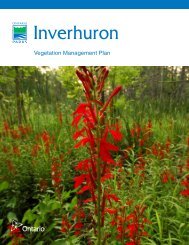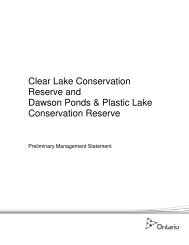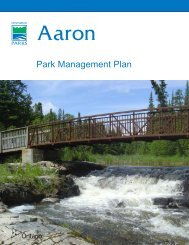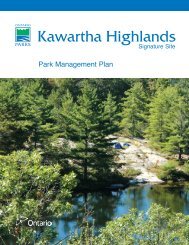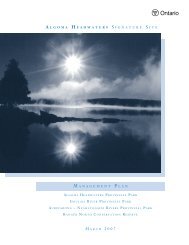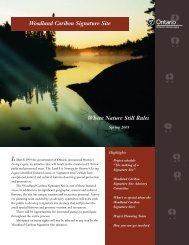Sandbanks Draft Veg Mgmt Plan - Ontario Parks
Sandbanks Draft Veg Mgmt Plan - Ontario Parks
Sandbanks Draft Veg Mgmt Plan - Ontario Parks
You also want an ePaper? Increase the reach of your titles
YUMPU automatically turns print PDFs into web optimized ePapers that Google loves.
APPENDIX E – Invasive Species Information Sheets<br />
Garlic Mustard<br />
Mustard Family<br />
Alliaria petiolata (M. Bieb.) Cavara and Grande<br />
Brassicaceae<br />
Common Names<br />
In North America, Garlic Mustard is the only common named used. Common names<br />
used for this species in England include; Hedge-garlic, Sauce-alone, Jack-by-the-Hedge,<br />
and Poor-man’s-mustard.<br />
Distribution<br />
Introduced from Britain, Belgium, and The Netherlands, and is native to Europe,<br />
commonly occurring south of 68º, and absent from the extreme south. This species also<br />
occurs in North Africa, India, Sri Lanka, and has spread to both North America and New<br />
Zealand.<br />
In <strong>Ontario</strong>, Garlic Mustard is established in the St. Lawrence- Great Lakes Deciduous<br />
Forest Region, and is most abundant in south western <strong>Ontario</strong> and in the Ottawa region.<br />
In the last 25 years, Garlic Mustard has spread to the Canadian Shield, and is now<br />
common in deciduous woods on the Shield.<br />
In SEZ parks, Garlic Mustard is known to occur in Charleston, Murphy’s Point,<br />
<strong>Sandbanks</strong>, Presqu’ile, Voyageur, Darlington and Petroglyphs.<br />
Biology and Ecology<br />
General Description: Garlic Mustard is a true biennial herb, and therefore completes its<br />
life cycle in two years. In the first year, basal rosettes develop, and are recognizable by<br />
June. The rosettes over winter and mature the following spring. Adult plants can grow to<br />
1.9 metres in height, and the plant averages one metre at the time of flowering.<br />
Leaves: Basal leaves are kidney-shaped with scalloped edges, and 6-10 cm in<br />
diameter. Stem leaves are alternate, sharply toothed, triangular, and are 3-8 cm long,<br />
becoming smaller toward the top of the stem. Petioles are pubescent and 1-5 cm long.<br />
Both the basal and stem leaves have a strong garlic odour when crushed, but the scent<br />
becomes weaker as the season progresses, and the scent is absent by fall.<br />
Flowers: Flowers are 6-7 mm in diameter, and consist of 4 white petals that narrow at<br />
the base. Six stamens are present, with two of the stamens shorter than the other four.<br />
Fruit: Fruit capsule 2.5-6 cm long and 2mm wide. Each plant produces an average of 4-<br />
16 capsules, with each capsule producing 10-20 seeds. The seeds are 3mm long and<br />
1mm wide and are black and diagonally ridged. Seeds are dispersed from mid June to<br />
September, and generally fall within a few metres of the parent plant.<br />
Similar species: May be confused with other rosette forming species, especially Viola<br />
spp. (violets). The strong odour can help distinguish Garlic Mustard from other species.<br />
The garlic odour is strongest in spring.<br />
Habitat: Garlic Mustard can be found in open forests, and edge habitats, as well as<br />
under isolated conifer trees. Garlic Mustard can also grow in full sun and full shade, but<br />
grows best in semi-shaded areas. As a disturbance adapted plant, Garlic Mustard is<br />
most commonly found in areas of repeated disturbance, and will stabilize when the<br />
<strong>Sandbanks</strong> <strong>Veg</strong>etation Management <strong>Plan</strong> A-9<br />
<strong>Ontario</strong> <strong>Parks</strong>, SE Zone<br />
2009





